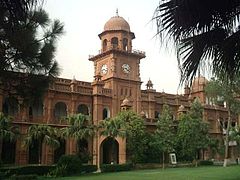The constitution of Pakistan requires the state to provide free primary and secondary education.[210] At the time of independence Pakistan had only one university, theUniversity of the Punjab.[211] As of September 2011 it has 136 universities, of which 74 are public universities and 62 are private universities.[212] It is estimated that there are 3193 technical and vocational institutions in Pakistan,[213] and there are also madrassahsthat provide free Islamic education and offer free board and lodging to students, who come mainly from the poorer strata of society.[214]After criticism over terrorists' use of madrassahs for recruitment, efforts have been made to regulate them.[215]
Education in Pakistan is divided into six main levels: pre-primary (preparatory classes); primary (grades one through five); middle(grades six through eight); high (grades nine and ten, leading to the Secondary School Certificate); intermediate (grades eleven and twelve, leading to a Higher Secondary (School) Certificate); and university programmes leading to graduate and postgraduate degrees.[213] Pakistani private schools also operate a parallel secondary education system based on the curriculum set and administered by the Cambridge International Examinations. Some students choose to take the O level and A level exams conducted by the British Council.[216]
The government is in a development stage[timeframe?], in which it is extending English medium education to all schools across the country.[217] Meanwhile, by 2013 all educational institutions in Sindh will have to provide Chinese language courses, reflecting China's growing role as a superpower and Pakistan's close ties with China.[218]
The literacy rate of the population above ten years of age in the country is 58.5%. Male literacy is 70.2% while female literacy rate is 46.3%.[175] Literacy rates vary by region and particularly by sex; for instance, female literacy in tribal areas is 3%.[219] The government launched a nationwide initiative in 1998 with the aim of eradicating illiteracy and providing a basic education to all children.[220] Through various educational reforms, by 2015 the ministry of education expects to attain 100% enrolment levels among children of primary school age and a literacy rate of 86% among people aged over 10.[221]


No comments:
Post a Comment